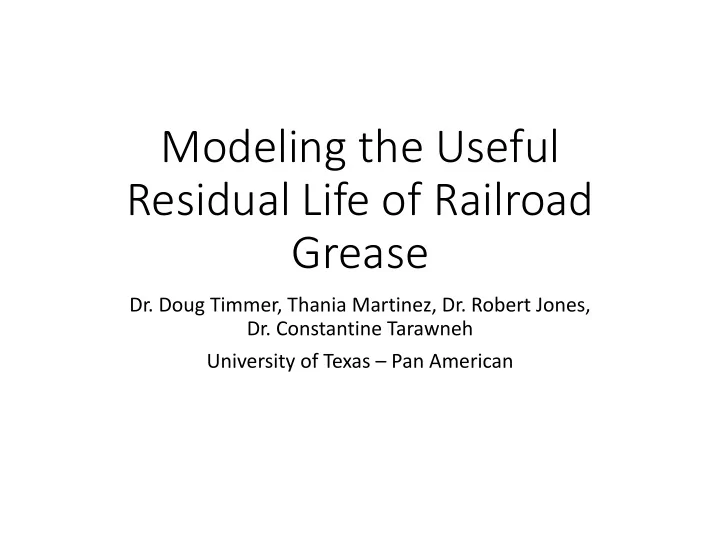

Modeling the Useful Residual Life of Railroad Grease Dr. Doug Timmer, Thania Martinez, Dr. Robert Jones, Dr. Constantine Tarawneh University of Texas – Pan American
Project Description • The degradation of grease used to lubricate railroad bearings is believed to occur due two processes: • Mechanical processes occurring within the bearing, • Oxygen diffusion. • Appropriate lubrication of the bearings is critical during railroad service operation. • This study focuses on the development of empirical models that can accurately predict the residual useful life of railroad bearing grease. • Employed Modeling Techniques: • Linear Regression Analysis • Regression Trees • Split Plots
Project Description (cont.) • The data set used in the development of the model consists of more than 100 samples of grease taken from the railroad bearings which were observed in a laboratory setting.
Laboratory Bearing Tester • Four bearings on the axle are subjected to the following experimental variables: • Load Conditions • Rotational Speed • Mileage • Temperature
Oxidation Induction Time • Oxidation Induction Time (OIT) is a test performed in a Differential Scanning Calorimeter (DSC) which measures the level of thermal stabilizers in the material. • The DSC produces a graph of heat flow vs time. • The time elapsed between the introduction of air into the cell and the decomposition of the sample reveals the time to oxidation which is then recorded as OIT. OIT Introduction of air into the cell Decomposition of the sample
Bearings • Three samples come from each bearing, giving a total of twelve possible samples from each axle. • Grease is sampled from the three critical locations of the bearing: • Inboard Cone Assembly Raceway • Outboard Cone Assembly Raceway • Spacer Ring Area
Linear Regression Plot for OIT vs Speed Regression(Linear): OIT vs Avg Speed 30 y = - 0.081x + 10.4 Inboard Outboard 25 Spacer Ring 20 OIT (min) 15 10 5 0 40 50 60 70 80 90 100 Speed (mph)
Regression Tree Min size split 20 • Add figure to the right
Experimental Design • Split, Split ‐ plot Design • Whole plot: axle ‐ setup • Sub plot: each bearing on axle • Sub, sub plot: sample location within each bearing • Single replicate • Unbalanced design
Unbalanced Data
Parameter Estimation • Restricted Maximum Likelihood (REML) • Implemented in Matlab • Degrees of Freedom are approximate due to unbalanced data
Representation of Bearing Location in Regression Model • The bearing location was recorded as a nominal value (1, 2, 3, 4) • Modeled using three indicator variables Dummy Variables Bearing X4 X5 X6 1 0 0 0 2 1 0 0 3 0 1 0 4 0 0 1
Representation of Grease Location in Regression Model • The grease location was recorded as a nominal value (1, 2, 3) • Modeled using two indicator variables Dummy Variables Grease X7 X8 1 0 0 2 1 0 3 0 1
Initial Model
Model 2
Model 3
Final Model
Final Model � • � � � • Where • ������� � � ������������� ����� • ����������� � � ��������������.�� ��.�� • � � is 1 if bearing 2 location, 0 for other bearing locations • � � is 1 if grease sampling location is the spacer ring and 0 for the inner or outer raceway
Future Research • Model Diagnostics • Residual analysis • R^2 • VIF • Model Refinement • Why is bearing 2 statistically different? • Is temperature a covariate (function of load, mileage and speed)? • Developing second response variable related to length of grease molecule • Alternative Model: neural network or ensemble of neural networks
Acknowledgements • University Transportation Center for Railway Safety (http://www.utrgv.edu/railwaysafety) for their support of this research • The Matlab code was provided by Dr. Marcus Perry, Associate Professor of Statistics, Culverhouse College of Commerce, University of Alabama
Recommend
More recommend